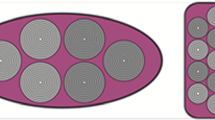Abstract
This paper focuses on the simulation of solar panel-based multiple output inverter including leakage inductance. The solar panel is used as the energy source and it is connected to a flyback converter to boost the voltage. The voltage output of the photovoltaic panel is boosted to 181.6 V from 16.5 V DC using an interleaved fly-back converter. Half-bridge multiple output inverter is used to produce alternating current in multiple coils. Using this circuit topology multiple loads can be heated simultaneously. All three coils are connected in parallel. If one coil is damaged then other coils will be able to provide the desired output. A wide range of output is studied in terms of current gain. In this proposed circuit two IGBTs have been used as semiconductor switches. Two freewheeling diodes are connected parallel to the IGBTs to provide the discharging path of the energized coils. Current variation through the coil is possible by varying the duty cycle. A simple asymmetrical duty cycle control strategy is used to vary the duty cycle. The available range of current is 2.18–2.43 A.














Similar content being viewed by others
References
Akkaya A, Kulaksiz AA (2004) A microcontroller-based stand- alone photovoltaic power system for residential appliances. Sci Direct 78:419–431
Bhaumik K, Datta A, Sadhu P (2017) Analysis of leakage inductance for multi-zone induction heater. Rev Roum Sci Techn-Électrotechn Et Énerg 62(4):388–393
Chandel M, Agarwal GD, Mathur S (2014) Techno Economic analysis of solar photovoltaic power plant for garment zone of Jaipur city. Case Stud Thermal Eng 2:1–7
Chauhan D, Agarwal S, Suman MK (2013) Policies for development of photovoltaic technology: a review. Int J Softw Hardw Res Eng 1:52–57
Daher S, Schmid J, Fernando LM (2008) Multilevel inverter topologies for stand-alone PV systems. IEEE Trans Industr Electron 55(7):2703–2711
Dhar S, Sadhu PK, Roy D, Das S, Das D (2020) Stability analysis of solar based induction heater. Microsyst Technol. https://doi.org/10.1007/s00542-020-04924-4
Hurley WG, Wilcox DJ (1994) Calculation of leakage inductance in transformer windings. IEEE Trans Power Electron 9(1):121–126
Islam SM, Sharif GM (2009) Microcontroller based sinusoidal PWM inverter for photovoltaic application. In: First international conference development in renewable energy technology. IEEE, pp 1–4
Jeyalakshmi A, Prabhakar M (2006) Effect of leakage inductance on the performance of parallel resonant converter
Kloub HA, Hamad EM (2015) Electromechanical modeling and designing of capacitive MEMS DC/AC interactive power inverter for renewable energy applications. Microsyst Technol 23(4):863–874. https://doi.org/10.1007/s00542-015-2767-1
Ko Y, Kim H, Mun Y, Lee B, Cho DD, Ko H (2018) 164 nW Inverter-based capacitive readout IC for microaccelerometer. Microsyst Technol. https://doi.org/10.1007/s00542-018-3707-7
Kokkonda K, Kulkarni PS (2021) A high gain soft-switching active-clamped coupled-inductor-based converter for grid-tied photovoltaic applications. Electr Eng. https://doi.org/10.1007/s00202-021-01250-4
Moniruzzaman MD, Hasan S (2012) Cost analysis of PV/Wind/Diesel Grid connected hybrid systems, pp 727–730
Sharath Kumar P, Vishwanathan N, Murthy BK (2015) Buck-boost interleaved inverter configuration for multiple-load induction cooking application. J Electr Eng Technol 10(1):271–279
Sudarsan MV, Babu CS, Satyanarayana S (2020) High-performance analysis of interleaved high-gain converter with active switched inductor using intelligent controller. J Supercomput 77(7):7212–7235. https://doi.org/10.1007/s11227-020-03546-x
Suresh PV, Sudhakar K (2013) Life cycle cost assessment of solar wind biomass Hybrid energy system for energy center. IEEE, Manit Bhopal
Szymanski JR, Zurek-Mortka M, Acharjee D (2020) Unidirectional voltage converter for battery electric vehicle ultrafast charger. Microsyst Technol. https://doi.org/10.1007/s00542-020-05038-7
Yen W-W, Chao PC-P (2020a) Backpack energy harvester managed by a modified fly-back converter. Microsyst Technol. https://doi.org/10.1007/s00542-020-05111-1
Yen W-W, Chao PC-P (2020b) Backpack energy harvester managed by a modified fly-back converter. Microsyst Technol. https://doi.org/10.1007/s00542-020-05111-1
Zope P, Bhangale P, Sonare P, Suralkar S (2012) Design and implementation of carrier based sinusoidal PWM inverter. Int J Adv Res Electr Electron Instrum Eng 1:230–236
Author information
Authors and Affiliations
Corresponding author
Additional information
Publisher's Note
Springer Nature remains neutral with regard to jurisdictional claims in published maps and institutional affiliations.
Rights and permissions
About this article
Cite this article
Bhaumik, K., Sadhu, P.K. Effect of leakage inductance on solar panel based multiple output inverter for induction heating system. Microsyst Technol 28, 2723–2729 (2022). https://doi.org/10.1007/s00542-022-05320-w
Received:
Accepted:
Published:
Issue Date:
DOI: https://doi.org/10.1007/s00542-022-05320-w




